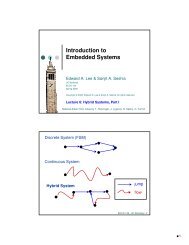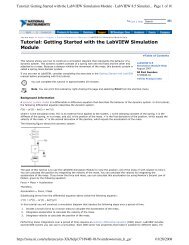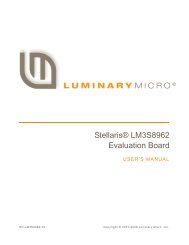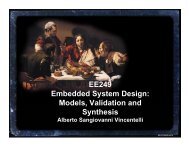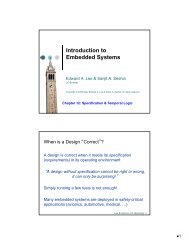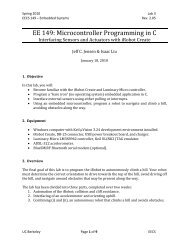Introduction to Embedded Systems - Chess
Introduction to Embedded Systems - Chess
Introduction to Embedded Systems - Chess
Create successful ePaper yourself
Turn your PDF publications into a flip-book with our unique Google optimized e-Paper software.
<strong>Introduction</strong> <strong>to</strong><br />
<strong>Embedded</strong> <strong>Systems</strong><br />
Edward A. Lee & Sanjit A. Seshia<br />
UC Berkeley<br />
EECS 149<br />
Spring 2009<br />
Copyright © 2008-09, Edward A. Lee & Sanjit A. Seshia, All rights reserved<br />
Lecture 6: Hybrid <strong>Systems</strong>, Part I<br />
Material drawn from notes by T. Henzinger, J. Lygeros, G, Pappas,<br />
S. Sastry, C. Tomlin<br />
Discrete System (FSM)<br />
Continuous System<br />
Hybrid System<br />
jump<br />
flow<br />
EECS 149, UC Berkeley: 2<br />
1
Topics in Today’s Lecture<br />
Examples of Hybrid <strong>Systems</strong><br />
The Hybrid Au<strong>to</strong>ma<strong>to</strong>n Model<br />
properties of this kind of model<br />
EECS 149, UC Berkeley: 3<br />
A Thermostat<br />
(happen instantaneously)<br />
EECS 149, UC Berkeley: 4<br />
2
Dynamics of Thermostat<br />
x<br />
82<br />
80<br />
70<br />
68<br />
on<br />
off<br />
t<br />
EECS 149, UC Berkeley: 5<br />
Hybrid Au<strong>to</strong>ma<strong>to</strong>n for Thermostat<br />
Is this au<strong>to</strong>ma<strong>to</strong>n deterministic?<br />
EECS 149, UC Berkeley: 6<br />
3
Formal Representation of Hybrid Au<strong>to</strong>ma<strong>to</strong>n<br />
EECS 149, UC Berkeley: 7<br />
Where do Hybrid <strong>Systems</strong> arise?<br />
Digital controller of physical “plant”<br />
thermostat<br />
controller for power plant<br />
intelligent cruise control in cars<br />
aircraft au<strong>to</strong> pilot<br />
Phased operation of natural phenomena<br />
bouncing ball<br />
biological cell growth<br />
Multi-agent systems<br />
ground and air transportation systems<br />
interacting robots (e.g., RoboSoccer)<br />
EECS 149, UC Berkeley: 8<br />
4
Another example<br />
Example due <strong>to</strong> George Pappas, UPenn<br />
EECS 149, UC Berkeley: 9<br />
Nuclear reac<strong>to</strong>r example (contd.)<br />
Example due <strong>to</strong> George Pappas, UPenn<br />
EECS 149, UC Berkeley: 10<br />
5
Hybrid Au<strong>to</strong>ma<strong>to</strong>n for Bouncing Ball<br />
x – vertical distance from ground (position)<br />
v – velocity<br />
c – coefficient of restitution, 0 c 1<br />
EECS 149, UC Berkeley: 11<br />
Behavior of Bouncing Ball Au<strong>to</strong>ma<strong>to</strong>n:<br />
Plot position x as a function of time t ,<br />
where x starts at height x max<br />
What kind of plot would you expect?<br />
EECS 149, UC Berkeley: 12<br />
6
Simulation of Bouncing Ball Au<strong>to</strong>ma<strong>to</strong>n in<br />
P<strong>to</strong>lemy II / HyVisual<br />
EECS 149, UC Berkeley: 13<br />
Zeno Behavior<br />
Informally:<br />
The system makes an infinite number of jumps<br />
in finite time<br />
EECS 149, UC Berkeley: 14<br />
7
A Run/Execution of a Hybrid Au<strong>to</strong>ma<strong>to</strong>n<br />
time<br />
EECS 149, UC Berkeley: 15<br />
Zeno Behavior: Formal Definition<br />
time<br />
EECS 149, UC Berkeley: 16<br />
8
Analysis of Zeno Behavior of Bouncing Ball<br />
EECS 149, UC Berkeley: 17<br />
Why does Zeno Behavior Arise?<br />
Our model is a mathematical artifact<br />
Zeno behavior is mathematically possible, but it is<br />
infeasible in the real, physical world<br />
Points <strong>to</strong> some unrealistic assumption in the model<br />
EECS 149, UC Berkeley: 18<br />
9
Hybrid Au<strong>to</strong>ma<strong>to</strong>n for Bouncing Ball: What’s<br />
Unrealistic about this model?<br />
x – vertical distance<br />
v – velocity<br />
c – coefficient of restitution, 0 c 1<br />
EECS 149, UC Berkeley: 19<br />
Eliminating Zeno Behavior: Regularization<br />
An instantaneous mode change (jump) is unrealistic<br />
What happens as ε goes <strong>to</strong> 0?<br />
EECS 149, UC Berkeley: 20<br />
10
Simulation for ε = 0.3<br />
EECS 149, UC Berkeley: 21<br />
Simulation for ε = 0.15<br />
EECS 149, UC Berkeley: 22<br />
11
Exercise: Construct a Hybrid Au<strong>to</strong>ma<strong>to</strong>n Model of<br />
iRobot Hill Climber<br />
EECS 149, UC Berkeley: 23<br />
12



